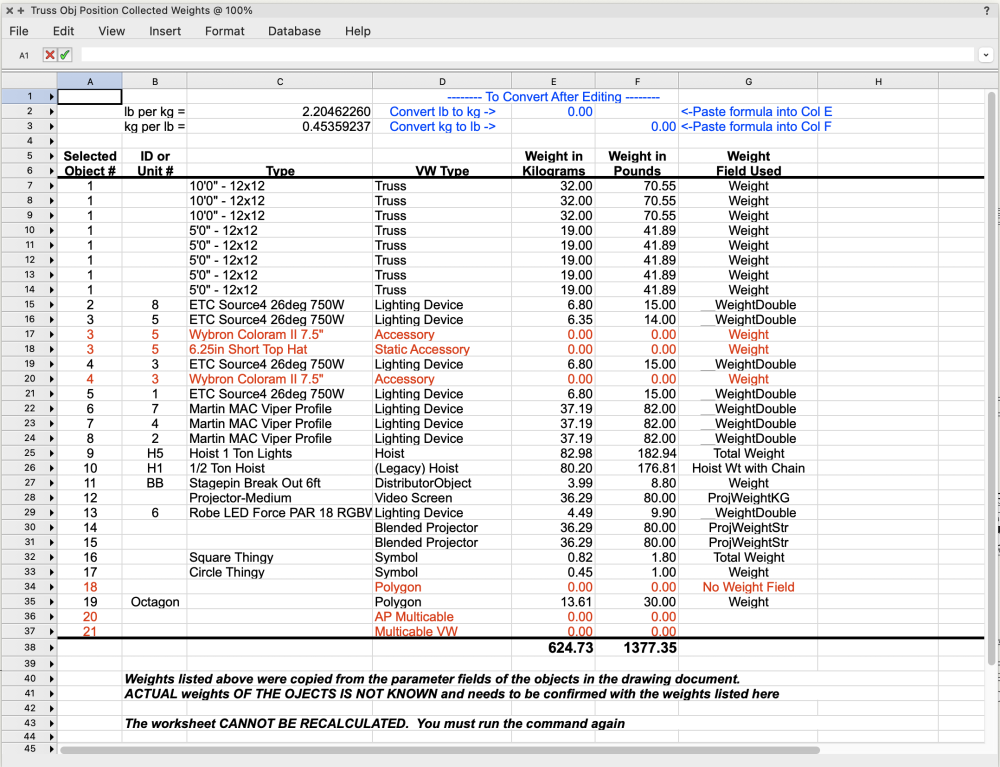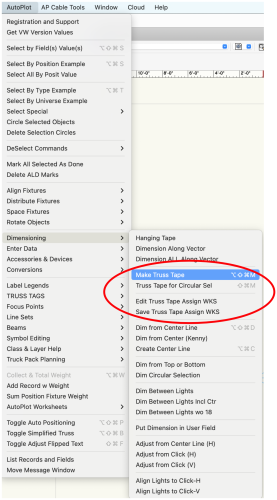-
Posts
1,191 -
Joined
-
Last visited
Content Type
Profiles
Forums
Events
Articles
Marionette
Store
Everything posted by Sam Jones
-
I don't think this is true. In my experience, dialogs only remember if the "Rpstr_ ..." commands to save values to the VectorScript value repository, and these values are only remembered during the current VW session. One can use the "SetSavedSetting()" and "GetSavedSetting()" commands to set and retrieve dialog settings during and between VW sessions. I defer to @JBenghiat for the source of all VS truth.
-
@Peter Neufeld.Your example didn't show any cable on the truss. Can you post an example with cable? I tried to add cable, and I couldn't even get the Hanging Position to recognize that the cable was on it. I'm not familiar with the new Power Planning cables, so I probably got that wrong. All other kinds of cable are transparent to Hanging Positions and are not reported in the Total Hung Weight. Thanks.
-
If you are using the new Power Planning cables, you are correct; the command is not reporting the Cable Run ID correctly. The same is true for legacy cable objects like the Multicable. The cable ID fields will need to be specified in the code of the command, and I will fix that today. If you are using another cable object, I would need to know what that is. Objects that the command does not explicitly know about will only have a field called "ID" reported, but I would be interested in collecting other VW ID field names. As for cable weight, that is a whole other matter. It is unlikely that cables will have any weight values to retrieve other than a "distributed weight" value like 0.74 lb/ft. There is no way for the command to know how the cable weight is distributed, for example how much is laying on the cable, how long the cable drop is if it exists, or how the weight is distributed by any cable pickup. You are going to need to figure out cable weights yourself and plug those weights into the worksheet. I doubt that ConnectCAD computes cable weights. It would need an undetermined number of fields to report different weights on different hanging positions that the cable path would run. If this is all a deal breaker for you, so it goes, and keep us informed as to the results of your quest for automatic cable weight reporting. It is possible that the new power planning cable will report weight to Braceworks in the future, but I am not seeing that happening yet. If you want to Zoom and talk about all of this, I'm in LA and 8 hours behind UK time, but I'm nursing a broken foot and can talk any time after 3PM UK time Sam sjones@autoplotvw.com
-
@stevenmorgan94method will work well, but only with objects that are recognized by the Hanging Position. The AutoPlot (AP) command will list every object that is selected and its weight. It will flag objects that have no listed weight and allow you to enter a weight value to be included in the weight total if you wish. Also it is unclear to me how the Total Hung Weight field collects weight for Video Screen and Blended Screen objects. Below is a screen shot of worksheet created by the AP command. I have also attached the command here. You will need to put it in the Plug-Ins folder that is inside your user folder and then add it to your workspace. The command should be fully functional for 2 months after you install it. You can download the full suite of AP commands at www.autoplotvw.com. Drop me a note if you have any questions or problems. Sam sjones@autoplotvw.com AP Collect and Total Weight.vsm
-
Try the attached plug-in by putting it in the Plug-Ins folder inside your VW user folder and then adding the menu command to your workspace. It is an AutoPlot Plug-in, but it is fully functional for 2 months from the first time you try to use it. It is faster than the Instrument Summary, and it reports the selected mode, but it is not a plug-in object, so you will have to re-run the command if you want to change the settings. Let me know if you have any questions or problems. Sam sjones@autoplotvw.com AP Instrument Summary.vsm
-
Using " 'LightPosition Obj'.'Position Name'='YourLPONameHere' " as a criteria is new and exciting. I was expecting to have to use a selection criteria like " ((R IN ['AP Light Position Obj'])) ". I can simplify many things by specifying record field values in the callback. Off to test now.
-
Thanks Pat. Not clear enough; go for it.
-
If I can get the name of a Light Position Obj (LPO)(Hanging Position), how can I get a handle to the LPO. Is the only option to cycle through all the LPOs until I find a match using a "ForEachObject() and GetRField(LPO, 'Light Position Obj', 'Position Name')? GetObject(name) won't work, because the name is not put in the "Name" field at the bottom of the LPO instance's OIP.
-
Please, please, please, is there any way to turn off auto completion in the Vectorscript editor. 90% of the time I do not want what is suggested and the other 10% of the time I can type faster than trying to figure out what to do next, but I'm still presented with ever more and more annoying suggestions as I type.
-
Try this theater seat plug-in: https://www.verysmallgroup.com/theaterow
-
Sorry, I don't use those tools. Hopefully, @Jesse Cogswell can help here.
-
I don't know what the "serie mode" is. Can you tell us the name of the command or give us a screen shot of the mode you are selecting? Also, are you using the current VW cable tools or the legacy cable tools?
-

Spotlight 3d fixture symbol added label does not rotate
Sam Jones replied to mkue's topic in General Discussion
@michaelk Very nice. -

Scripting/ Getting Started/ Advice, etc.
Sam Jones replied to Ryan Russell's topic in General Discussion
Since Python is often taught in Secondary school, wait for those who know it to chime in. -

Scripting/ Getting Started/ Advice, etc.
Sam Jones replied to Ryan Russell's topic in General Discussion
What Pat said. Vectorscript (VS) is clearer and easier. Python has better string handling (I'm told), and programming requires a lot of string handling. However, for me, dealing with the lack of a debugger and a lack of requiring explicit variables and variable types, would make my life hell. There are many people who do a lot of really cool scripting with Python, so I have to think that I'm just too old and lazy to learn another program language syntax. I already know Basic, PL-1, Forth, and Pascal, but I would venture into the SDK and the C++ compiler before dealing with Python. Someday I should tell you how I really feel.😊 -

Spotlight 3d fixture symbol added label does not rotate
Sam Jones replied to mkue's topic in General Discussion
@Pat StanfordI got noth'n. -
I can confirm that this will work. Thanks. FWIW, if VW is going to include the legacy hoist, what would be the effort cost to put such a symbol in the folder mentioned in the shipping version? Hmm?
-
Where is this class? How do I access this class? How do I store data in a (this) class? TIA!
-
When I place a "Legacy Hoist Origin" object, only the "Cable ID" gets placed. No graphic identifying the location of the hoist origin is placed (shown?). This kills the Legacy Hoist as an option. What am I missing? I hope I'm missing something.
-
@JBenghiat Please confirm: Get/SetObjectVariableBoolean() will handles "Boolean" values Get/SetObjectVariableInt() will set "handles "short"values Get/SetObjectVariableLongInt() will handles "double" values Get/SetObjectVariableReal() will handles "real" values Get/SetObjectVariableString() will handles "TXString" values What handles (gets/sets): "Sint32" "TransformMatrix" "void" write "RefNumber" Are the constants labeled "Public for VS" the only ones accessible to vectorscript? Yet again, TIA.
-
To flesh out @michaelk response, AutoPlot Tools for Spotlight is a large collection of tools for entertainment drafting. There is a set of commands for making truss tapes: If you have questions and/or want a demonstration, let me know. Sam sjones@autoplotvw.com www.autoplotvw
-
I would assume that if the symbol desired is not in the document that "GetObject()" would fail. If he has already loaded the needed symbols into the document, then, absolutely, GetObject() is the way to go. If he needs to get it from another file, I think he needs to build a resource list. No?
-
If you want to use symbols from the VW Resource Manager you would need to do some kind of table look up to match "D" to symbol name, and you would need to get a resource list ID, "BuildResourceList()" or "BuildResourceList2"(). Then you would need to iterate through the list to find a name in the table that matched what was considered equivalent to the "D" symbol. Retrieve that symbol and place it. After that, you fill in the fields that you need to fill in. There are some variations to this, but nothing much simpler.
-
We'll need more specifics as to what you mean by "update" a record. Exactly, how do you want change what field in what record. Are the values (both field name and field value) being changed the same across all libraries? Does the record exist in libraries you do not want to change? Does the record exist outside of the libraries? There is probably a brute force method of collecting field values and field links, and then re-defining the the records and reassigning the links and values. I haven't done this, but tell us the specifics.




